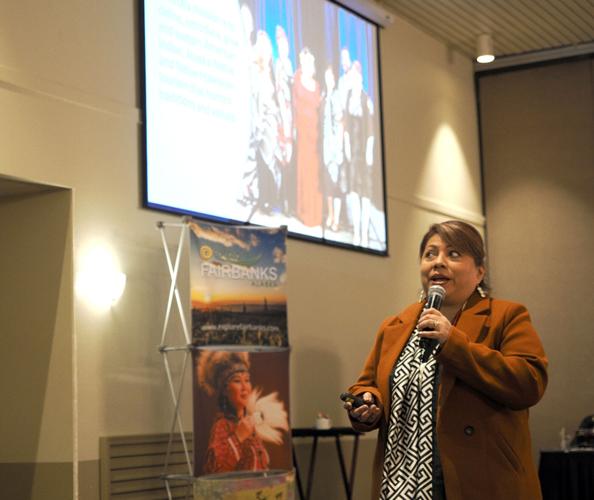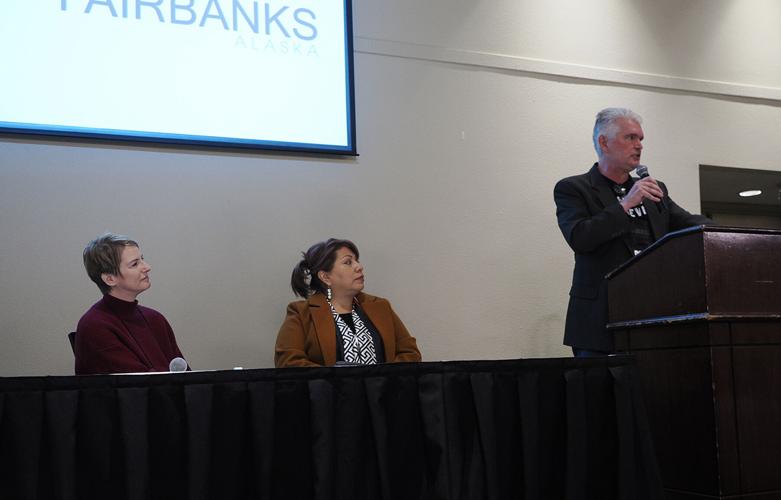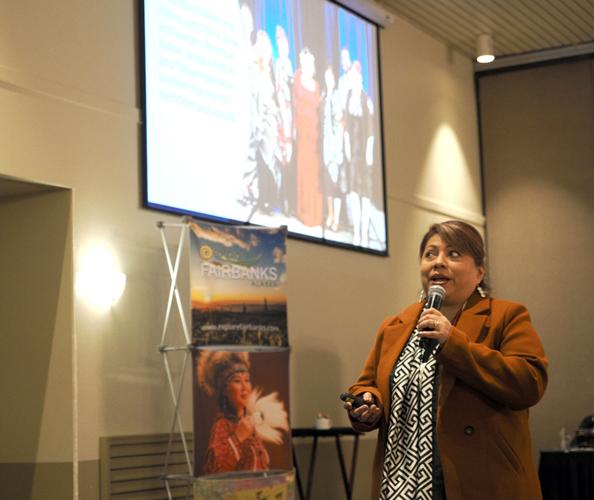A three-day Alaska Heritage and Cultural Tourism Conference took place in Fairbanks last week, highlighting the benefits of integrating Indigenous history into regional tourism efforts.
Sitka Tribal Enterprises, the economic development arm of the Sitka Tribe of Alaska, established the 10-year Heritage and Cultural Tourism Conference in 2015. Traditionally held in Sitka, the University of Alaska Fairbanks won the bid to host this year’s event.
The conference began with a traditional land acknowledgment and an invocation from the Rev. Dr. Anna Frank, a respected elder of Old Minto and a longtime leader in the Interior Alaska Native community.
Sessions focused on economic opportunities, best practices, marketing strategies, cultural responsibility, ethics and sensitivity, and general tourism industry updates.
“It’s a subject that comes up a lot,” said Bill Wright, Explore Fairbanks’ marketing and tourism director.
Tanana Chiefs Conference Chief and Chairman Bryan Ridley emphasized that cultural tourism not only benefits the region economically but also provides a platform to share history, traditions, and stories with others.
“Cultural tourism allows us to share those stories with the world in a way that honors our values and preserves the integrity of who we are as Alaska Native people,” Ridley said. “It’s not just about attracting visitors; it’s about sharing our identity in a respectful, authentic, and sustainable way. It’s about making sure the next generation sees that our cultures are alive, thriving, and deeply connected to the lands we call home.”
Camille Ferguson, economic development director for the Sitka Tribe, pointed to Sitka’s tourism history as an example. Once the 19th-century capital of Russian America and a major trade hub, the city’s tourism industry was long centered around its Russian heritage.
“Our people weren’t part of the tour,” said Ferguson, who began working as a tour guide in 1997. “Back then, there were no real Native culture tours. So when people got off the cruise ships, they would only learn about the Russian history.”
Ferguson made it a point to tell visitors about her Tlingit heritage, as well as the local edible and medicinal plants.
“I wanted people to know Sitka is a multicultural community, that it has different cultures and heritages, and that Alaska is diverse,” she said. “We have to let people know we are still here.”
Ferguson noted that Alaska is home to 229 federally recognized tribes — more than the Lower 48 combined — and 22 Native languages across nine major cultural regions.
“Everything has a story behind it, and the people who live in Alaska can tell it,” she said. “What’s changed over the last few years is that people are being showcased more — who they are, their regalia, and their art is actually getting shared.”
Sherry Rupert, CEO of the American Indian Alaska Native Tourism Association (AIANTA) and a member of Nevada’s Washoe Tribe, said cultural and heritage tourism has grown into a $15.7 billion industry in the United States.
In 2019, just before the Covid-19 pandemic, there were 120,869 American Indigenous-owned tourism firms — three times the number in 2017. That number rose to over 133,000 in 2020.
Rupert said international tourists, in particular, tend to stay longer in areas focused on Native culture and heritage than in other destinations. She emphasized that investing in place-based tourism and revitalizing historical sites can help preserve cultural legacies while also supporting local economies.
“We’re seeing this more and more across the nation as tribes and Alaska Native villages work hard to ensure their stories are heard,” Rupert said. “We want to share our stories to educate others and perpetuate our culture.”
She pointed to the former Stewart Indian School in Carson City, Nevada, as an example. For 90 years, until 1980, about 30,000 Native American children were forced to attend the boarding school, often enduring assimilation-focused curricula that prohibited traditional languages and practices until at least 1935.
The school was closed when the Carter administration cut funding to Native boarding schools. The Washoe Tribe later established the Stewart Indian Colony on the site, and Nevada now uses it for state-sponsored classes, training centers, and government offices.
In 2017, the state began renovating some of the campus’s 65 buildings to create a cultural and welcome center, which opened in 2020. The tribe also developed a walking tour with audio stories from alumni and staff, accessible via QR codes.
“We were reclaiming the space,” Rupert said.
AIANTA has funded several Alaska-based projects, including renovations at Metlakatla’s Camp Hemlock and Natural Trails, the Alutiiq Museum and Archaeological Repository in Kodiak, the Karsaan Tourism Improvement Project, and other initiatives across Southeast Alaska.
Scott McCrea, president and CEO of Explore Fairbanks, said Fairbanks’ status as a year-round destination makes it ideal for cultural tourism.
“While conversations about cultural tourism are relatively new for us, the fact is that people wanting to experience Indigenous culture in Alaska is as old as Alaska tourism itself,” McCrea said, noting that even in the early 20th century, visitors were drawn to Alaska Native art and crafts.
He said the second-most common question Explore Fairbanks receives — after where to view the northern lights — is where to find Alaska Native crafts and cultural experiences.
“Coming out of the pandemic, people want authentic experiences more than ever and want to connect with the culture of a place,” McCrea said.
He cited local examples: Riverboat Discovery’s walking tour of the Athabascan Chena Village, Doyon Limited’s Doyon Tourism initiatives, the World Eskimo-Indian Olympics in July, and UAF’s Festival of Native Arts in February. The Morris Thompson Cultural and Visitors Center also serves as a key resource.
“The one challenge we have in Interior Alaska is that demand exceeds supply,” McCrea said. “We need more products and programs available year-round.”
Jillian Simpson, president and CEO of the Alaska Travel Industry Association (ATIA), said the organization has made major investments in promoting cultural tourism. In recent years, ATIA added a board seat specifically for Alaska Natives to ensure Indigenous perspectives have a voice.
That board member chairs ATIA’s Cultural Enrichment Committee, which guides the organization’s cultural tourism strategy. About 21% of Alaska’s 3 million annual visitors participate in cultural tourism activities.
Four percent of ATIA’s $5.75 million marketing budget is allocated to cultural tourism, but Simpson emphasized that Alaska’s heritage is embedded throughout all of its messaging.
“It is embedded in everything we do,” she said.
ATIA’s Indigenous-focused content is created by Alaska Native writers, photographers, and content producers. Despite the modest budget, Simpson said this content has had an outsized impact, reaching millions each year.














